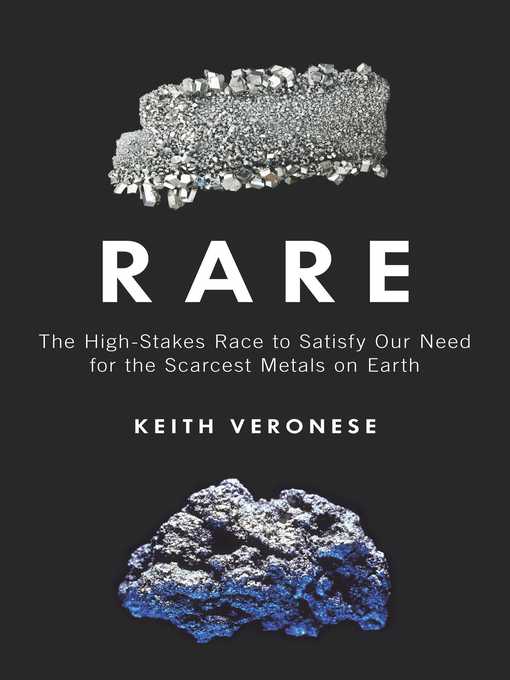- Featured Magazines
- Let's Get Cooking!
- News, Politics, and Business
- Lifestyle Magazines
- Popular Magazines
- All Magazines
- See all magazines collections
Rare
The High-Stakes Race to Satisfy Our Need for the Scarcest Metals on Earth
In addition to explaining the chemistry behind rare earth metals, Rare delves into the economic and geopolitical issues surrounding these "conflict minerals," blending tales of financial and political struggles with glimpses into the human lives that are shattered by the race to secure them. In the past decade, the Congo has been ravaged by tribal wars fought to obtain control of tantalum, tungsten, and tin supplies in the region, with over five million people dying at the crossroads of supply and demand. A burgeoning black market in China, Africa, and India is propped up by school-age children retrieving and purifying these metals while risking their lives and health in the process. Fears of future political struggles inside China, the world's largest supplier of these metals, have already sent the United States, Great Britain, and Japan racing to find alternative sources.
Will scientists be able to create lab substitutes for some or all of these metals? Will Afghanistan be the next big supplier of rare metals? What happens when the limited supply runs out? Whatever the answers, it is clear that our modern lifestyle, dependent on technology, is far from stable.
From the Hardcover edition.
-
Creators
-
Publisher
-
Release date
January 6, 2015 -
Formats
-
Kindle Book
-
OverDrive Read
- ISBN: 9781616149734
-
EPUB ebook
- ISBN: 9781616149734
- File size: 1603 KB
-
-
Languages
- English
-
Reviews
-
Publisher's Weekly
October 27, 2014
In this work of popular science, journalist Veronese (Plugged In: Comic Book Professionals Working in the Video Game Industry) delivers a scattershot account of the discovery and chemistry of metals, addressing their critical roles in technology and the cutthroat struggles over extraction, trade, and recycling. Despite the absence of an overarching theme, readers won’t be bored. Veronese focuses to some degree on the political and environmental challenges related to meeting global demand for the “rare earths”—17 metals with odd names (yttrium, terbium, dysprosium) essential for the production of high-tech electronics—repeatedly returning to this subject before wandering off on tangents. Topics of interest include thorium, which turns up as a clean source of nuclear power, and polonium, a poison used in political assassinations. A chapter discusses daredevil American hobbyists who extract precious metals from discarded electronics and addresses the massive Third World dumps where thousands make a miserable living doing the same. Veronese also discusses Afghanistan, whose vast untapped mineral resources hold the potential to ease its political problems. Though most of his subject minerals are obscure and relatively unknown even to educated readers, Veronese presents an informative and entertaining, if disorganized, overview of the metallurgy and politics of rare metals. Photo insert. Agent: Laura Wood, FinePoint Literary Management. -
Library Journal
January 1, 2015
The general public is likely to hear the term rare earth metals and think of gold, silver, and maybe platinum; but to chemists, it conjures a completely different picture. These 17 elements are present in small amounts around the world, with larger concentrations in a handful of places, particularly China. Here Veronese (chemistry writer, io9 website; Plugged In: Comic Book Professionals Working in the Video Game Industry) attempts to explore the politics, economics, and uses of these elements. Unfortunately, the objective becomes confused when the author at various times chooses to discuss the truly rare metals (e.g., gold, platinum, and beryllium) instead of the rare earth elements that he establishes early as the true focus of the book. He even decides to discuss graphene, a form of carbon, which is anything but rare. While its topics are certainly intriguing, the book suffers from a lack of direction as well as some poor choices of analogies and metaphors. VERDICT Recommended for scientists interested in the less-explored elements of the periodic table and those curious about the politics and economics of rare (earth) metals.--John Kromer, Miami Univ. of Ohio Lib., Oxford, OH
Copyright 2015 Library Journal, LLC Used with permission.
-
Formats
- Kindle Book
- OverDrive Read
- EPUB ebook
subjects
Languages
- English
Loading
Why is availability limited?
×Availability can change throughout the month based on the library's budget. You can still place a hold on the title, and your hold will be automatically filled as soon as the title is available again.
The Kindle Book format for this title is not supported on:
×Read-along ebook
×The OverDrive Read format of this ebook has professional narration that plays while you read in your browser. Learn more here.


